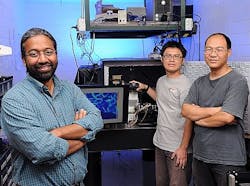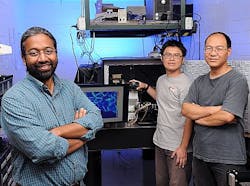Dual microscopy method studies single biological molecules
Pairing atomic force microscopy (AFM) and optical microscopy, researchers in the Ames Laboratory at Iowa State University (Ames, IA) have developed a way to complete 3D measurements of single biological molecules with unprecedented accuracy and precision. The new method enables height measurements (the z axis) down to the nanometer without custom optics or special surfaces for the samples.
The research program, led by Sanjeevi Sivasankar, an assistant professor of physics and astronomy and an associate of the U.S. Department of Energyâs Ames Laboratory, aims to learn how biological cells adhere to each other and to develop new tools to study those cells.
The researchers' methodâstanding wave axial nanometry (SWAN)âentails attaching a commercial atomic force microscope to a single-molecule fluorescence microscope. The tip of the atomic force microscope is positioned over a focused laser beam, creating a standing wave pattern. A molecule that has been treated to emit light is placed within the standing wave. As the tip of the atomic force microscope moves up and down, the fluorescence emitted by the molecule fluctuates in a way that corresponds to its distance from the surface. That distance can be compared to a marker on the surface and measured.

